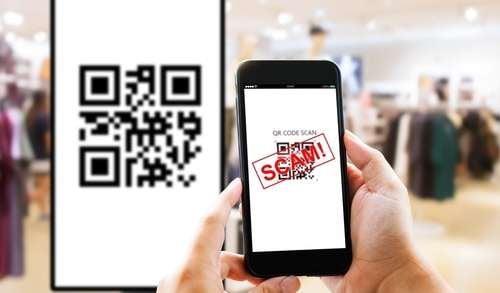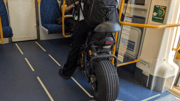Protect your personal and financial data from this unassuming scheme that could cost you thousands!
By
Danielle F.
- Replies 11
In an age where convenience is king, the rise of cashless transactions has been a boon for many Australians.
However, with this shift towards digital payments, a new form of scam has emerged, targeting unsuspecting Aussies and conning them out of thousands of dollars.
A form of scam called 'quishing' uses QR codes—the square-shaped barcodes that have become visible in everyone's daily lives.
These codes come in many uses—from checking in at venues to paying for parking or ordering a meal.
As people grow accustomed to the convenience QR codes bring, citizens are also becoming vulnerable to scammers and their devious tactics.
Electronic Frontiers Australia Chair John Pane raised the alarm on this growing threat.
Scammers have been exploiting QR codes to infect devices with malware to steal personal information and redirect victims to malicious sites.
Scammers place fake QR code stickers over legitimate ones in public places, such as parking metres or venue check-in points.
When scanned, these fraudulent codes lead to counterfeit websites that could harvest your personal and financial details.
Victims of quishing have since reported being signed up for unwanted services, like gym memberships, or having small, regular payments syphoned from their accounts.
The threat of quishing is not limited to financial loss.
Pane warned about the risk of metadata collection, which could include the type of device people are using, IP addresses, and any location information.
This data can be used to track online behaviour or even expose financial data.
This scam has been reported across Australia, the United Kingdom, and the United States.
Australia's ScamWatch noted about $100,000 in losses since 2020.
Additional data also stated that 56 reports of phishing scams involved QR codes last year alone.
Trusted entities like Services Australia and the Australian Taxation Office have been impersonated by these scammers, with fake QR codes that could lead to counterfeit sites designed to steal personal details.
In North Sydney Council, the transition to cashless metres required users to provide extensive personal information, which sparked privacy concerns among citizens.
So, how can you protect yourself from this terrifying cashless scam? Here are some tips:

Have you encountered any suspicious QR codes during your day out? Share your experiences with us in the comments below to help raise awareness within our community.
However, with this shift towards digital payments, a new form of scam has emerged, targeting unsuspecting Aussies and conning them out of thousands of dollars.
A form of scam called 'quishing' uses QR codes—the square-shaped barcodes that have become visible in everyone's daily lives.
These codes come in many uses—from checking in at venues to paying for parking or ordering a meal.
As people grow accustomed to the convenience QR codes bring, citizens are also becoming vulnerable to scammers and their devious tactics.
Electronic Frontiers Australia Chair John Pane raised the alarm on this growing threat.
Scammers have been exploiting QR codes to infect devices with malware to steal personal information and redirect victims to malicious sites.
Scammers place fake QR code stickers over legitimate ones in public places, such as parking metres or venue check-in points.
When scanned, these fraudulent codes lead to counterfeit websites that could harvest your personal and financial details.
Victims of quishing have since reported being signed up for unwanted services, like gym memberships, or having small, regular payments syphoned from their accounts.
The threat of quishing is not limited to financial loss.
Pane warned about the risk of metadata collection, which could include the type of device people are using, IP addresses, and any location information.
This data can be used to track online behaviour or even expose financial data.
This scam has been reported across Australia, the United Kingdom, and the United States.
Australia's ScamWatch noted about $100,000 in losses since 2020.
Additional data also stated that 56 reports of phishing scams involved QR codes last year alone.
Trusted entities like Services Australia and the Australian Taxation Office have been impersonated by these scammers, with fake QR codes that could lead to counterfeit sites designed to steal personal details.
The move towards cashless parking metres has exacerbated the issue.In North Sydney Council, the transition to cashless metres required users to provide extensive personal information, which sparked privacy concerns among citizens.
So, how can you protect yourself from this terrifying cashless scam? Here are some tips:
- Always inspect a QR code before scanning it. If it seems out of place, do not scan it.
- If you're using a QR code for payment or personal data entry, ensure it's provided by a trusted source, such as an official website or directly from a service provider.
- Be wary of entering personal details on any site you've accessed through a QR code. Look for signs of legitimacy, such as secure URLs beginning with 'https'.
- If you encounter a potential QR code scam, report it immediately to relevant authorities like Scamwatch or the organisation being impersonated.
- Keep up to date with the latest scam warnings from consumer groups and government agencies.
Key Takeaways
- Australians have been warned about a quishing scam where fraudsters replace legitimate QR codes with malicious ones.
- Electronic Frontiers Australia stated that these scams could result in malware infections, which could harvest personal and financial information from victims.
- Several quishing incidents have already been reported in Australia, the UK, and the US, with losses in Australia reaching about $100,000 since 2020.
- People were advised to be cautious when scanning QR codes and to avoid providing personal information through suspicious QR-based systems.








